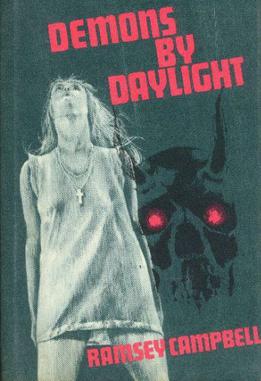 By RAMSEY CAMPBELL (Arkham House; 1973)
By RAMSEY CAMPBELL (Arkham House; 1973)
This collection was the fabled second book by the great Ramsey Campbell and is widely considered a landmark in scare fiction. Campbell’s first effort was the Arkham House published INHABITANT OF THE LAKE AND LESS WELCOME TENANTS, a collection of Lovecraft-inspired tales which appeared back in 1964, when the author was still a teenager. DEMONS BY DAYLIGHT was apparently completed in 1968, but publication was delayed several years due to the death of Arkham’s founder August Derleth.
…widely considered a landmark in scare fiction.
One thing that must be said about this collection is that the influence of H.P. Lovecraft, so evident in THE INHABITANT OF THE LAKE (whose contents later appeared in revised form in the 1985 collection COLD PRINT), has been almost completely expunged. That was apparently no accident: the new book’s title, as Campbell would later point out, was inspired by a line from an attack on Lovecraft that read “now the demons walk in daylight”. In short, DEMONS BY DAYLIGHT represents a brilliant author emerging from the shadow of his predecessor and finding his own voice.
This does not, however, necessarily make for a compelling read. The stories have an insular quality, with frequently sluggish prose grouped into clunky paragraphs that lack the accessibility of Campbell’s later work. Those critics who dub this book a groundbreaker may well be correct (I wasn’t exactly paying attention to literary trends back in 1973 and so am hardly in a position to gauge its impact), yet I think it’s best viewed as a transitional volume.
I think it’s best viewed as a transitional volume.
One element these fourteen stories have in common is an unapologetically British sensibility. All are set in various parts of Campbell’s native England, which definitely set the tone for what was to come from this quintessentially English writer. There is also a steadfast determination to subvert convention; this explains “The Interloper”, a tale of steadily building unease that concludes in the most low-key manner imaginable. The horrific climax of “The Sentinels” is nearly as subdued, being a description of something dimly glimpsed from a considerable distance. Then there’s the last line of “The Old Horns,” which introduces a note of poetry (literally) into an otherwise relentlessly dark narrative.
One element these fourteen stories have in common is an unapologetically British sensibility.
Grit is another common element. The hallucinatory apprehension of Campbell’s descriptions, one of his inimitable trademarks, was in full flower here, but leavened somewhat by his almost documentary-esque presentation of late sixties’ England. “The Enchanted Fruit” imparts a vision of terror and ecstasy reminiscent of the great Arthur Machen, yet never loses sight of its constricting walls-and-concrete environ.
In many of the tales the supernatural element is so subtly evoked as to be almost nonexistent. “The End of a Summer’s Day”, DEMONS BY DAYLIGHT’S best piece, may be a sinister evocation of reality displacement or just a straightforward account of a woman losing her husband in a cave. “The Guy” might describe an act of revenge from beyond the grave or just a Halloween prank, while the final pages of “Made in Goatswood” could be detailing a supernatural enchantment or a nervous breakdown.
From just about any other author DEMONS BY DAYLIGHT would seem an undoubted (if turgid) masterwork. Campbell, however, was moving onto bigger and better things: check out subsequent collections like DARK COMPANIONS and WAKING NIGHTMARES, or just about any of his novels (THE FACE THAT MUST DIE in particular), to experience a literary genius at the height of his powers. As for DEMONS BY DAYLIGHT, I recommend it, but not nearly as highly.
